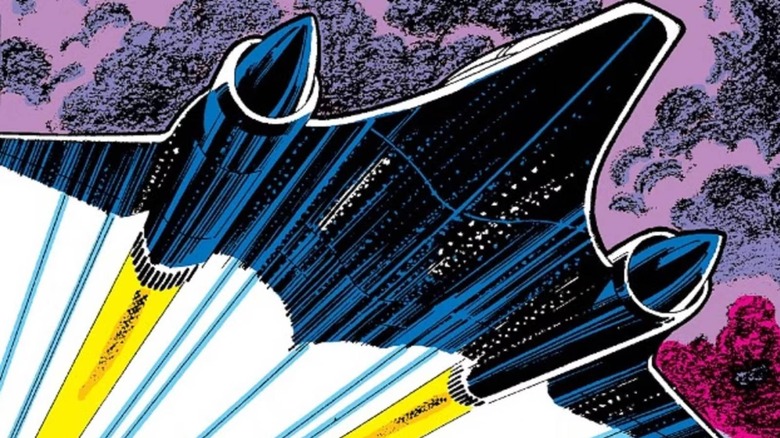
Marvel Comics
Some superheroes are fortunate enough to have the power of flying, allowing them to get anywhere on the globe (or even to space) in a relatively short amount of time. Others can run fast or even teleport to make travel a breeze. Then again, there are the heroes who don’t have any of that. Even if they only have a single city to patrol, hoofing it on foot can be a tall order. That’s when it comes in handy to have a sweet ride ready and waiting so they can go off to fight crime and look good doing it.
Naturally, the most famous superhero ride is Batman’s Batmobile. Some of the best Batmobiles of all time are straight out of the movies, from Adam West’s classic ride to the Tumbler in «The Dark Knight» trilogy. It’s one of the most iconic film and TV cars ever made, superhero-related or not. As such, it’s high time to pay tribute to some of the other awesome superhero vehicles, many of which have been relegated to the pages of comic books but could be due for a live-action adaptation any day now.
This list ultimately boils down to which superhero rides are simply the coolest — the ones fans would love to get behind the wheel of. Some are souped-up cars, while others take to the skies. They come with features that can take a B-grade hero into the A list. These are the vehicles that would make even Superman jealous.
The Fantasticar
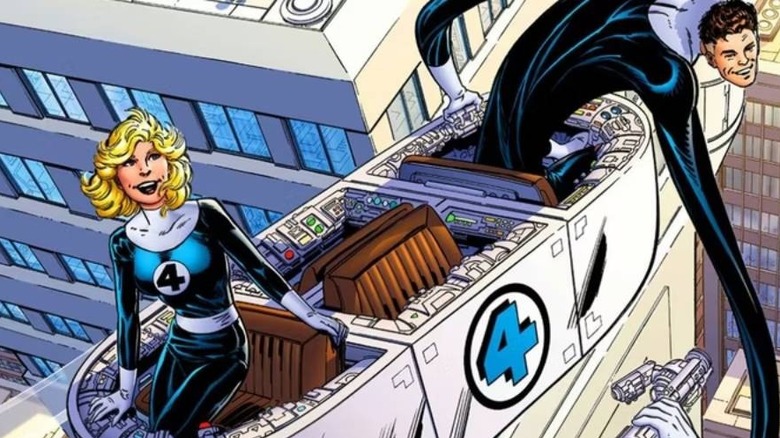
Marvel Comics
Any family needs a ride suitable for the entire clan, and the Fantastic Four are Marvel’s first family. The Fantasticar made its debut early on in the Fantastic Four’s existence. The transport module was introduced in 1962’s in «Fantastic Four #3» by Stan Lee and Jack Kirby. The vessel could fly through the air, but it had the unfortunate qualifier of looking like a bathtub, with a seat in the front, a seat in the back, and two in the middle arranged back to back.
While a flying bathtub may have worked for the hokier sensibilities of the 1960s, the Fantasticar underwent various iterations over the years, usually looking more jet-like in later appearances. This includes a leap to the big screen with 2007’s «Fantastic Four: Rise of the Silver Surfer.» While it looks different from its original iteration, it does include one noteworthy aspect the Fantasticar tends to have, which is the ability to split into various pieces so that each member of the team can control their own separate portion.
However, it appears the original Fantasticar may still get some love in the movies. Some leaked set photos suggest it will appear in «Deadpool & Wolverine,» with some characters driving around in a big, white, tub-looking vehicle. The aesthetic works well for the sillier tone something like «Deadpool 3» will have, but the Fantastic Four will more than likely need something a bit sleeker when they return to cinemas.
Thanos-Copter
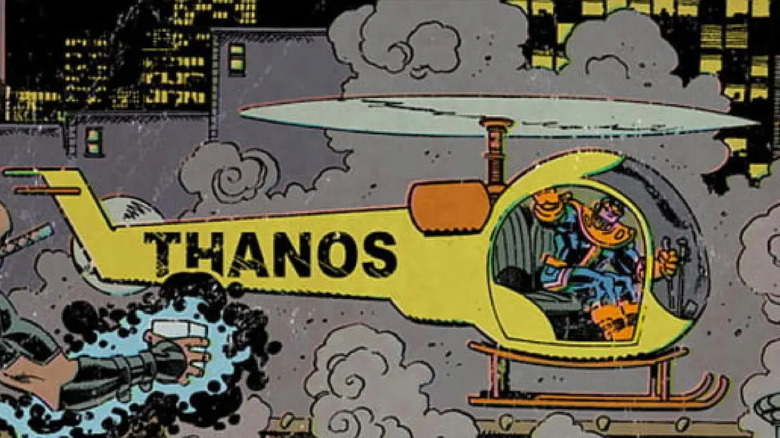
Marvel Comics
Thanos, played by Josh Brolin, was built up as the big bad of the Marvel Cinematic Universe. When he finally retrieved all of the Infinity Stones, he was the deadliest force in the universe. As such, it’s kind of funny to think about a version of him flying around in a yellow helicopter. And yet, the Thanos-Copter was first introduced in 1978, created by Nick Sullivan, Jim Calicrup, Michael Siporin, and David Anthony Kraft.
The best (or worst, depending on your vantage point) part of Thanos’ helicopter is that it doesn’t seem to have any special gadgets. It’s just a yellow helicopter with Thanos’ name on it — it’s hard not to respect that level of vanity. And despite its low-tech nature, the helicopter is among Marvel’s most legendary vehicles. It regularly gets invoked in other media, whether it’s in an issue of «Deadpool» or as an Easter egg in «Loki.» The Thanos-Copter is an utter anomaly and a constant reminder that superhero stories weren’t always the serious affairs they tend to be today. They could have something like a purple alien riding around in a helicopter, and no one would bat an eye.
That’s not to say the Thanos-Copter couldn’t be a threat with the right upgrades. The top attack helicopters used in war can deal some serious damage. Maybe someday, someone creative will reinvent the Thanos-Copter as a force to be reckoned with. Until that time, it’ll remain an awesomely goofy part of Marvel’s history.
X-Men’s Blackbird
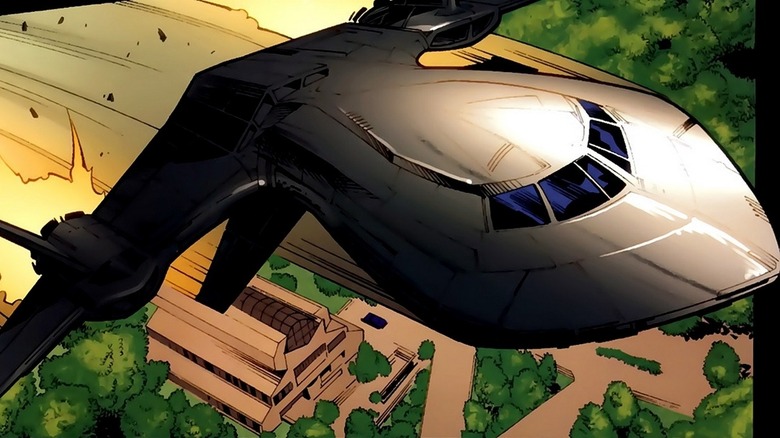
Marvel Comics
The Blackbird, seen in various X-Men media, is based on the already incredible SR-71 Blackbird, a legendary supersonic spy plane. Stealth continues to be the name of the game in X-Men comics and movies, as the superhero team’s Blackbird is primarily used for camouflage and getting to various locations undetected. In the comics, such cloaking technology comes courtesy of the intergalactic Shi’ar Empire. The Blackbird first appeared in «X-Men» #104, created by Chris Claremont and Dave Cockrum.
Given the appearances of some X-Men members, as well as the general prejudice exhibited against them, it makes sense the group would need a way to travel across cities without people seeing them. The Blackbird is such an integral component to the team that it’s been regularly featured throughout the X-Men’s filmography, even being called the X-Jet in 2000’s «X-Men.» It’s established that Hank McCoy (Nicholas Hoult) designed the aircraft, which would be used throughout numerous adventures, even getting destroyed from time to time in both «X-Men: The Last Stand» and «X-Men: Days of Future Past.»
Whether one calls it the Blackbird or X-Jet, it has a rich history to rival that of the Batmobile. It has gone through numerous iterations and received various upgrades throughout the decades. The fact that it comes with vertical takeoff, which comes in handy when needing to keep the vessel underground much of the time, is just the cherry on top.
Blue Beetle’s Bug
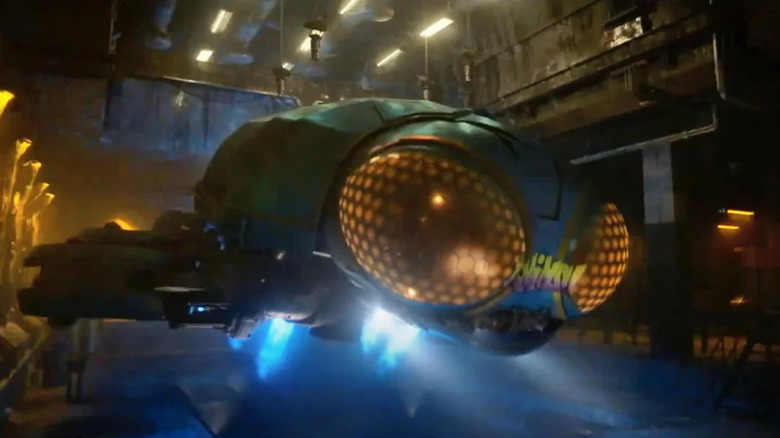
Warner Bros.
If Blue Beetle wanted to stay on-brand, he could’ve simply gotten a Volkswagen Beetle, which already comes with cool and unique features. But Ted Kord took it up a notch with his invention — the Bug — a giant, beetle-looking vessel that flies through the air, barely making a sound. Writer Steve Ditko first introduced the Bug in 1967’s «Captain Atom» #87, and it’s come in handy numerous times over the decades.
In addition to antigravity units to keep it virtually silent, the Bug also boasts an impressive array of weapons, including laser beams. Plus, Ted Kord obviously wants to do right by the environment, which is why the Bug features solar power capabilities. One could even say Blue Beetle’s Bug is even more powerful than Batman’s Batmobile. Its array of features even includes a portable crime lab, allowing Ted Kord to bring criminals to justice without having to go back to a stationary lab.
Ted Kord may not have been physically present in 2023’s Blue Beetle movie, but some of his inventions still got some screentime, including the legendary Bug. As an additional fun fact, Blue Beetle served as the inspiration for Nite Owl in Alan Moore and Dave Gibbons’ «Watchmen.» That’s also why the Owlship in that graphic novel looks so similar to the Bug. It’s a neat, if not slightly tenuous, connection to arguably the best graphic novel ever written.
Wonder Woman’s Invisible Plane
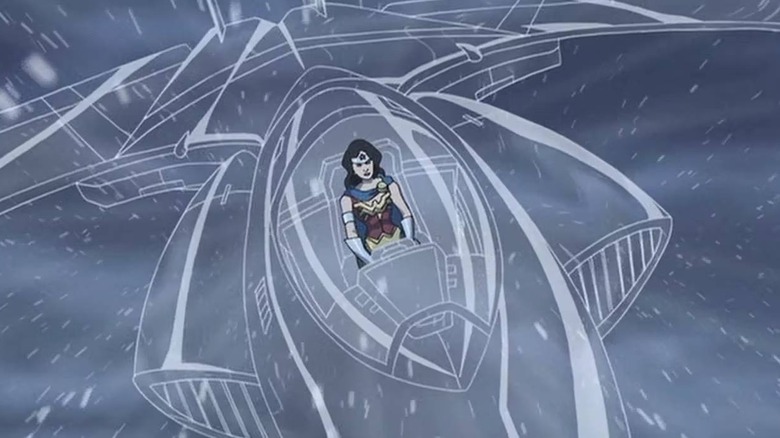
Warner Bros. Animation
The Invisible Plane has been around almost as long as Wonder Woman herself. The jet made its debut in «Sensation Comics» #1 from writer William Moulton Marston and artist Harry G. Peter. As suggested by its name, the primary feature of this vessel that makes it stand out is the fact it’s invisible. It’s usually depicted as transparent with Wonder Woman in the pilot’s seat; however, it’s explained in one issue that Wonder Woman being seen is a narrative convenience for the reader. In the DC universe, no one can see Wonder Woman by herself sitting in the air.
The plane also comes packed with invisible missiles. It’s the ultimate aircraft when it comes to stealth, which makes sense for Wonder Woman as the Amazonians naturally want to keep themselves hidden from the rest of the world. While the Invisible Plane has received various origins over the years (as is typical in comic books), the most widely known is that it’s see-through due to Amazonian magic. That explanation was even used in «Wonder Woman 1984» where Diana (Gal Gadot) imbues a regular plane with invisibility so that she and Steve Trevor (Chris Pine) can escape pursuit.
The plane coming into play is often dependent on whether Wonder Woman can fly in a given continuity. She couldn’t originally fly, but she’s gained that power over the years. She doesn’t have invisible missiles on her own, though, so the plane still comes in handy for that.
Lobo’s Spacehog
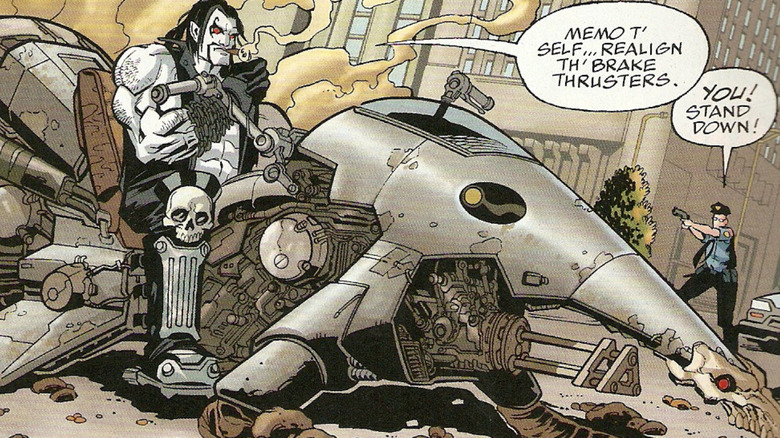
DC Comics
You can’t have the nickname «Main Man» and not have a sweet ride. Fortunately, Lobo has one of the baddest in the universe with an outfitted SpazFrag666, which he affectionately refers to as the Spacehog. Rather than try to describe this beauty of engineering, it’s best just to go by this description from 1990’s «Lobo Vol. 1» #2: «It boasts a miniaturized 17-liter powerplant with 3x Turbo and full HandsOff facility. Zero to 60 is instantaneous, and top speed is a cool several million kays per minute. It runs on Unleaded.» Readers have Alan Grant, Keith Giffen, and Simon Bisley, among others, to thank for that issue.
Given Lobo’s entire aesthetic right down to his Spacehog, it’s understandable why he became a breakout character. As a bounty hunter, he rides that fine line between good and bad, usually just out for himself willing to sell anyone out for the right price. If Lobo enters the picture, it’s a safe bet his space bike won’t be far behind, as it’s even leaped into animated film territory with appearances in «Justice League: Warworld» and «Superman: Man of Tomorrow.»
The Spacehog does more than simply look cool. It also apparently gives whoever rides it the ability to breathe and speak while in space. One thing’s for sure — when Lobo and his Spacehog cruise into town, it’s best to get out of dodge.
Ghost Rider’s Hell Cycle
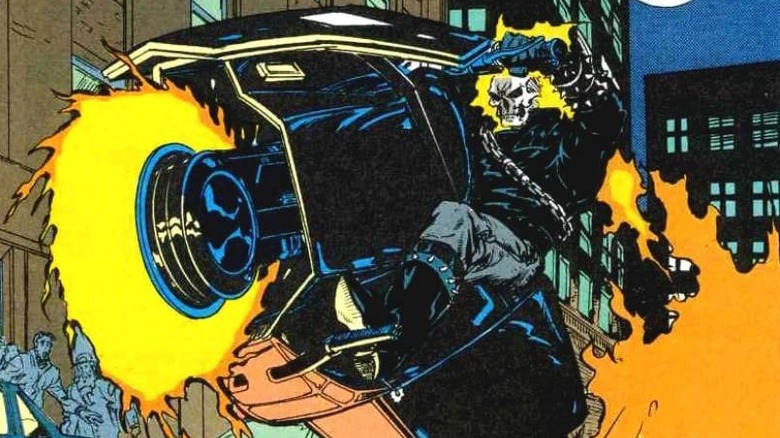
Marvel Comics
Similar to Lobo’s Spacehog, Ghost Rider’s Hell Cycle just makes sense for the character. It’s the transportation method of choice for all Ghost Riders, as decided by Mephisto. A flaming motorcycle designed by the equivalent of Satan? It doesn’t get much more rock ‘n’ roll than that.
There have been many Ghost Riders over the years, each having their own Hell-themed vehicle. Occasionally, something other than a flaming motorcycle comes to the forefront, such as the Hell Charger, a flaming 1969 Dodge Charger — a car that’s worth quite a bit of money today even if it isn’t infused with Hellfire. However, the character is most often affiliated with his iconic motorcycle, which comes with the ability to travel at impressive speeds and go over virtually any surface, including water.
It’s also pretty convenient that most Ghost Riders have some kind of connection to vehicles before they receive the power of Hellfire. Johnny Blaze is a stunt performer specializing in motorcycle tricks, while Robbie Reyes works as a mechanic. It almost seems as though these characters are predestined to become Ghost Riders eventually, which is probably the way Mephisto likes it.
Turtle Van
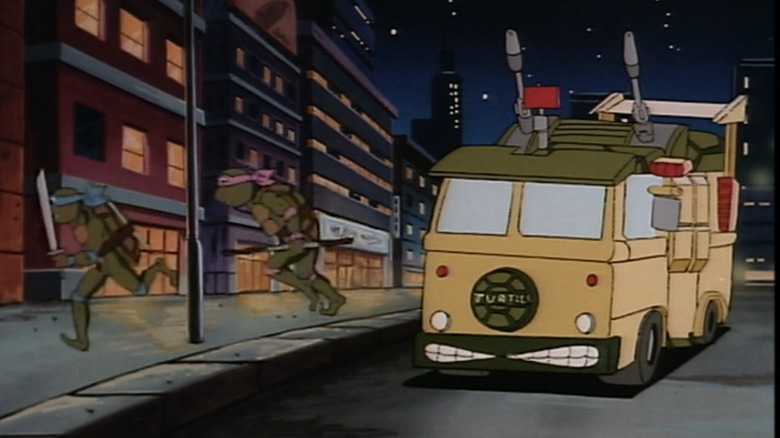
Fred Wolf Films
The Teenage Mutant Ninja Turtles need to remain out of sight, lest the world learn there are giant, talking turtles running amok. While they typically parkour around rooftops, sometimes they need a quicker way to move about the city, and that’s where the Turtle Van comes into play. Given that it features all sorts of turtle-related items on the cover, it’s not exactly what one would call low-key. Maybe people think the van belongs to a terrarium-cleaning business or something.
It’d be tough for four huge turtles to fit in a standard sedan, what with their shells likely bumping into one another. However, a van is a pretty suitable vehicle for transporting the brothers, as well as April O’Neil and anyone else they may have along for the ride. The Turtle Van is basically a regular van outfitted with some turtle-specific accessories that have been a valuable asset on numerous adventures. The vehicle makes regular appearances in the 1987 «Teenage Mutant Ninja Turtles» cartoon series, which is likely where most fans were introduced to it. Through various incarnations of the franchise, the van has usually appeared in some shape or fashion, even if it’s just a basic Volkswagen in the 1990 live-action movie.
They may call it the Party Wagon from time to time, but Turtle Van has such a nicer ring to it. Just from looking at it, one can’t help but yell, «I love being a turtle!»
Mooncopter
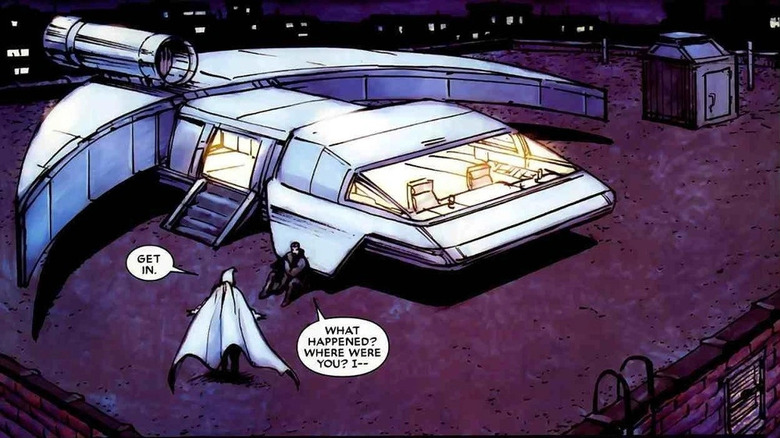
Marvel Comics
It’s been said that Moon Knight is pretty much Marvel’s answer to Batman. They both have gimmicks related to the night (namely, moons and bats), and they both tend to have an array of gadgets and weaponry related to said themes. Seeing as Batman has planes at his disposal to fly around Gotham, it’s only natural for Moon Knight to get his own hovercraft as well, and the Mooncopter is an excellent one, created by Doug Moench and Don Perlin. And just like how Batman’s gear tends to come in the shape of a bat, the Mooncopter usually features a crescent moon in its design so that bad guys know precisely who they’re going up against.
Granted, that’s assuming they even realize the Mooncopter is en route. The aircraft features silencing capabilities, so no one can hear the vessel approach. It allows Moon Knight to sneak up on his enemies, which is another Batman similarity as they both typically utilize the element of surprise to gain an upper hand. The Mooncopter is also loaded with weapons, which is handy when Moon Knight needs to kill combatants. That’s one way in which he’s differentiated from the Dark Knight; Moon Knight has no qualms over taking a life.
The Mooncopter is so cool that it almost makes up for the fact that it’s not really a helicopter. But when it boasts antitank missiles and automatic chain gun cannons, the name becomes a minor detail.
Spider Machine GP-7
The Japanese «Spider-Man» TV series from the 1970s is one of the greatest oddities to emerge from the realm of comic books. Long before comic book adaptations dominated the zeitgeist, there was this wacky series based on arguably the most popular comic book character ever. While Spider-Man has had various vehicles throughout his existence, he’s mostly known for simply swinging around New York City. Of course, the Japanese show didn’t concern itself with what had worked in the comics and went completely over the top in its new direction. That included giving Spidey the Spider Machine GP-7, a flying car with missiles and lasers.
Missiles may seem like overkill when dealing with the likes of Big Wheel, but Japanese Spider-Man had to contend with the aliens of the Iron Cross Army, so he needed some extra firepower. In addition to the Spider Machine GP-7, he had the Marveller, a spacecraft that can transform into the giant mech Leopardon. Because it wouldn’t be a true tokusatsu series without a giant robot fighting monsters.
The show had nothing to do with Spider-Man as most people know him, to the point where Marvel never wanted the show to leave Japan. Naturally, that didn’t happen, and it’s a good thing the rest of the world became aware of its existence. Watching Spider-Man maneuver a flying car while firing machine guns is brilliantly deranged. It goes to show how a great superhero vehicle doesn’t always need to make sense; it just needs to be wickedly cool.